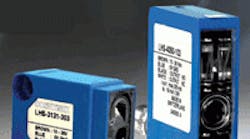Understanding background-suppression sensors
Photoelectric sensors with background suppression are a more evolved version of the basic diffuse sensors used on public washroom sinks to control automatic faucets. Both in this rudimentary commercial installation and more complex industrial applications, all diffuse sensors emit light and use the objects they detect as reflectors — which means that they must adapt to myriad object materials and surface properties.
In fact, diffuse photoelectric sensors are color dependent, and this characteristic is often leveraged in sophisticated units to distinguish dark and light targets for sorting or quality control. That said, matte, nonreflective targets can pose a challenge, and bright white objects extend sensing ranges, necessitating background suppression for consistency.
More specifically, third-generation background suppression is boosting performance in even the most complex automation tasks: As we'll explore, sensors with this type of background suppression solve the problems of detecting components of different sizes on one conveyor; identical but different colored items from the same distance; and counting identical but differently colored items into batches.
Background suppression lesson
Originally, false triggers caused by reflective backgrounds and varied sensing distances spurred the development of background suppression. All iterations are diffuse-sensor functions that zero in on key objects while disregarding background signals.
-
First-generation fixed-field background suppression includes an emitter that sends out a beam of light for a pair of receivers: One is focused on the optimal target distance, and the other on the more distant background. A comparator then contrasts the light intensities collected by these receivers, and the sensor outputs signals when light collected by the focused-receiver is brighter than that of the distantly focused receiver; otherwise, it remains inactive.
-
Second-generation diffuse-sensor background suppression uses an array of receivers with an adjustable sensing distance. A potentiometer allows electronic range adjustment (though the sensors operate best at their preset focal spot.) Allowing for small part recognition, diffuse sensors with second-generation background suppression also exhibit better target-area cutoff tolerances and color sensing. Even so, target surface qualities such as glossiness degrade results, and reflective objects outside the sensing area can send enough light back to the receivers to trigger output, especially when the receivers are electronically adjusted.
-
Third-generation diffuse-sensor background suppression addresses these limitations with triangulation. Here, the sensors measure the angle of incidence (rather than the amount) of light reflected back to the receiver. This provides stability when color variations or reflective backgrounds are problematic. Why? Reflectivity and color affect the intensity of reflected light, but not the angles of refraction used by these units.
In short, the light pulse from the emitting diode leaves the optical system as a focused, almost parallel, light beam. On meeting an object in its path, part of the beam is diffusely reflected, and in turn, part of this reflected light falls on a focusing lens to a position-sensitive device (PSD) housed in the same sensor. Depending on the distance of the target from the device, the light falls on a particular spot of the PSD, and a corresponding reception signal is emitted, indicating that an object is present at a certain distance from the device.
Finally, an analyzing circuit compares the signal received with that at the preset operating distance, and if the object's distance is less than or equal to the preset operating distance, output is generated.
Operating distance is independent of the target color, shape, or surface. The angle of received light is adjusted by means of a three-turn potentiometer with position indication, allowing for a well-defined cutoff (to 0.1 mm) between target and background. In fact, the optics in some units give a quasi-linear output function with a negligible blind zone of less than 1 mm at s = 300 mm, and analog output featuring reliable white-gray characteristics. Some units also eliminate intermediate digitalization, so sensor resolution is virtually unlimited.
Triangulation at work: Application examples
One typical triangulation-based background-suppression application is differentiating soda flavors by the colors of their caps — for example, red for cola, green for lemon-lime, and black for diet. Here, photoelectric background-suppressed sensors can detect them all, from one distance, no matter the color.
Sensors with triangulating background suppression can also be used to tally piled objects of varied color — for example, to verify paperclip quantities in boxes of red, green, blue, and silver paperclips traveling on a conveyor. Depending on the sensor's distance from the paperclips, the light they reflect falls on a particular spot of the PSD, and corresponding reception signals are emitted to indicate how many paperclips are present.
As mentioned, operating distance depends very little on the target size, color, or surface: Unlike operation with intensity-sensing (energetic) varieties, objects are easily discerned, even against a light background. The only caveat is that these devices are not suitable for objects having extremely shiny surfaces.
For more information, visit contrinex.com/products_finder_Photoelectric.asp.
